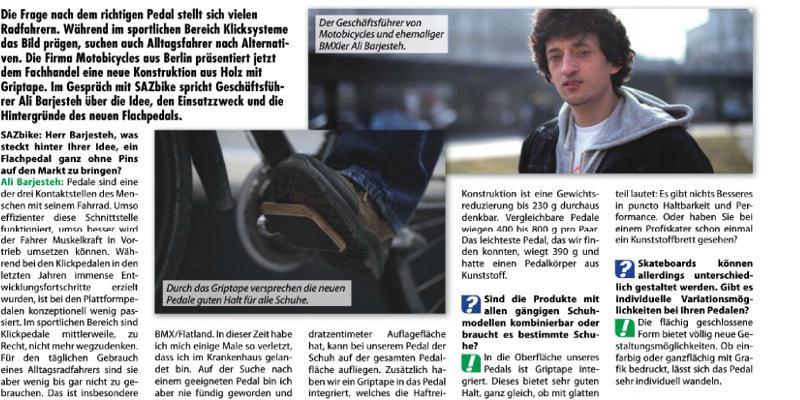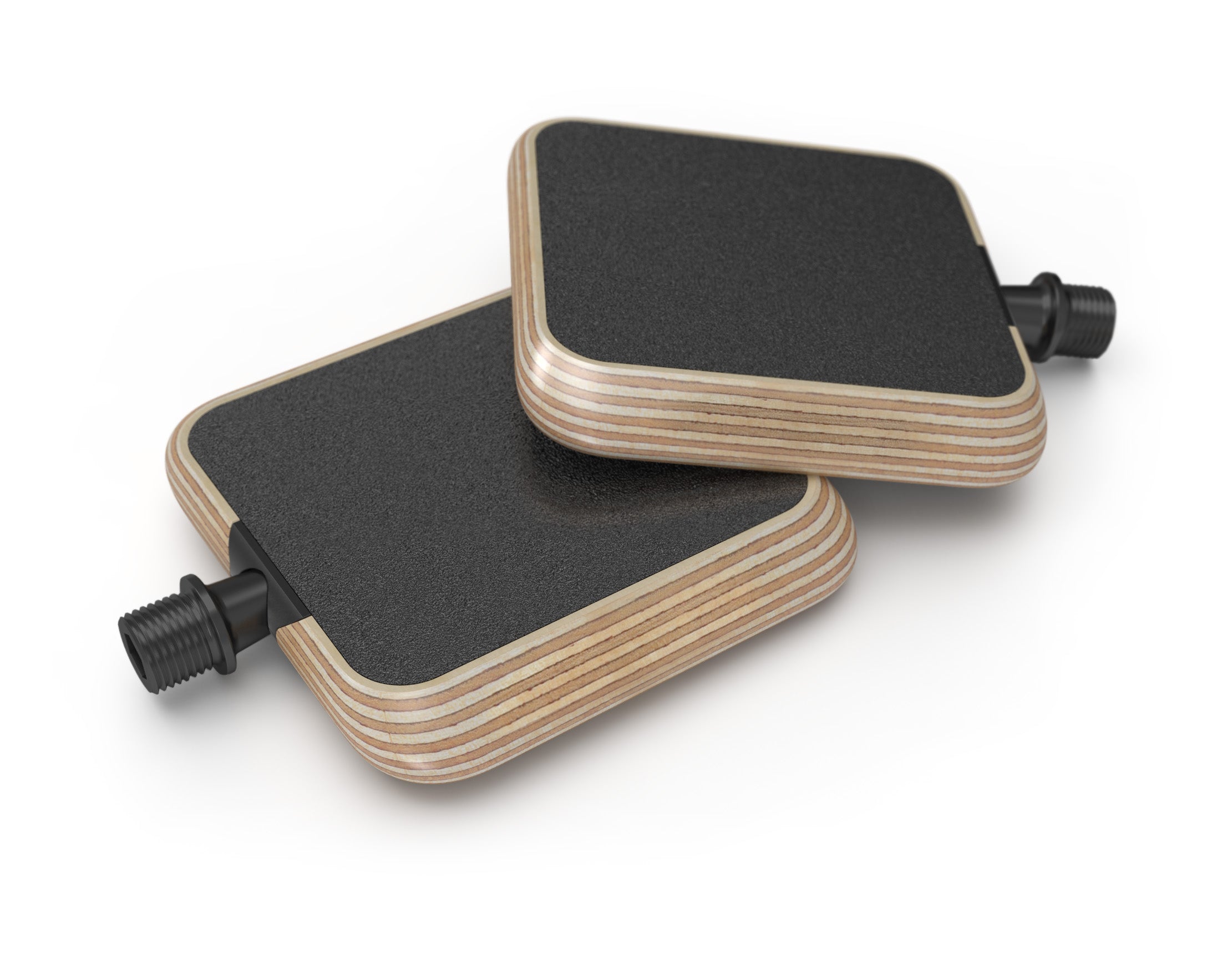Urban Flat Pedals - Blog
Flat pedals and shoes - MOTO In an interview with SAZ Bike

Flatl pedals and shoes - ,,Pins, plastic and metal are not the right materials for bicycle pedals“ - SAZbike spoke with Ali Barjesteh, Managing Director of Motobicycles:
Picking the right bicycle pedal is a challenge many cyclists find themselves posed with. On the sports scene, clipless pedals dominate. Elsewhere, everyday cyclists are seeking alternatives. Motobicycles, a company based in Berlin, has introduced a new alternative to the market. The innovative flat pedal is constructed from wood and Griptape. In an interview with SAZbike, Ali Barjesteh, talks about the idea and the background of the new flat pedal.SAZbike: what is behind your idea of bringing a pin-free flat pedal onto the market?
Pedals are one of three contact points between you and your bike. The more efficiently this contact point works, the better your muscle power can be harnessed to propel your bike. There’s been a lot of development in the field of clipless pedals in recent years, but very little innovation when it comes to platform pedals. In the sporting sector, clipped in pedals have become indispensable, and rightly so. However, they are of little, if any, use to the daily demands of your average cyclist. For one, special footwear is needed to operate clipless pedals, which adds a layer of inconvenience to a daily schedule. There’s also comfort implications to consider. When developing the ‘Motopedal’, it was important for us to eliminate the weaknesses of conventional platform pedals. Our objective was to design an ergonomic flat pedal that was compact, lightweight and incredibly safe to use.How did you come up with the idea for the product?
Just take a look at my shins and you will get your answer. I’ve been riding BMX Flatland for 20 years now. During this time, I’ve injured myself so much that I’ve ended up in hospital. But when it came to looking for a suitable pedal, I never had any luck finding one. Eventually, it was a skateboarding friend of mine who helped sow the seeds of an idea.
Do you have any development experience yourself?
When it comes to testing and deciding on material, it’s hard to pull the wool over my eyes. I have spent more time in testing on bicycles than other people do at the office desk. For the construction, we brought an aerospace engineer on board. Working closely together, we were able to create an extraordinary product.
What ergonomic advantages do Motopedals offer over conventional flat pedals?
When it comes to ergonomics, our pedal offers a much larger contact area than other pedals. With conventional pin pedals, the shoe often rests only on the pins, therefore reducing the amount of available contact surface. With our pedal, the shoe can instead rest on the entire surface. In addition, we have integrated Griptape into the pedal design, which serves to increase the static friction, ensuring the shoe is more securely fixed to the pedal. In general, positioning on the pedal is significantly improved. Without using pins or teeth and doing away with sharp corners and edges, there’s no danger of injuries to the cyclist.
Can the pedals be used with any available shoe type, or do certain shoes need to be worn?
Griptape integrated into the surface of our pedal. This offers a very good degree of grip, even with footwear with smooth soles or non-slip shoes. Even high-heeled shoes and leather soles can be used with these pedals without any problems. This is true even when the surface is wet.
Have you ever seen the state of leather soles that have been worn to ride with pin pedals? Nobody with an expensive shoe collection needs to worry about this sort of damage again. Worth noting is that you won’t find any pins on escalators or aircraft steps either. Instead, you find anti-slip coatings. We’re confident that pins, metal and plastic are completely the wrong approach to pedal surfaces.
What materials is the pedal made of?
We only use high quality materials. The axle is CNC machined from hardened steel. Glass-fiber reinforced plastic and plywood are used in the pedal body.
Pedals can take some beating by the rider. How safe are the woode pedals from scratches and scuffs?
The meticulously processed plywood has no disadvantages when compared to conventional pedals. The effects of regular use and wear are just as visible as other pedal materials, but the difference here is that the Motopedal can be repaired. Generations of skateboarders have put this material to good use. Their verdict is: there’s nothing better in terms of durability and performance. Let’s put it another way – have you ever seen a plastic board at a professional skateboard jam?
What does the pedal weigh?
The Motopedal is probably the lightest platform pedal on the market. Our wooden model comes in at only 320 grams per pair. Our patent-pending construction means a weight reduction of up to 230 grams is something quite conceivable. Comparable pedals come in at around 400 to 800 grams per pair. In fact, the lightest pedal we could find was a plastic model. weighing in at 390 grams.
How long does the grip last for?
Depending on your individual riding style, the grip tapes should last between 6 to 12 months. It’s easy for anyone to change old grip tape and replace it with new one in as little as five minutes. In the future, we will of course offer replacement via our dealers, as well as via our website directly.
Skateboards may be designed differently, however. Are there customisation possibilities with your pedals?
The flat, closed form offers completely new design possibilities. The pedal can be individually customised with a single colour or printed with graphics across the entire surface.
How else does your bike pedal differ in design?
Thanks to a newly developed, patent-pending bearing, the distance between platform and crank-arm can be set by 5mm. The ultra-flat and lightweight design also sets it apart from competitors.
What target group are you aiming at with these flat pedals?
The target group is any cyclist who uses a flat pedal today. This is the majority of cyclists. The only exception would be bikers who regularly ride in muddy terrain. The benefits of the pedal are otherwise interesting for cyclists who want to connect in an optimum way with their bike. This way, they can achieve maximum propulsion and enjoy a more comfortable, safer ride.
Are the pedals of interest to mountain bikers?
One of the advantages of our bicycle pedal is that it offers a much better slip resistance compared to conventional pedals, especially in wet conditions. They’re a good option for mountain bikers who aren’t riding in muddy terrain.
When will your products be available?
We want to launch the pedals in the second and third quarter 2012.
How does distribution work?
We aim to sell our pedals through specialist dealers. We’ll be working directly with some dealers in order to facilitate this. Otherwise, we also plan to cooperate with wholesalers.
What role do internet orders play?
In order to be able to meet customer demand, especially during the early stages, we will also be offering the pedal via direct sales. However, we’re convinced we are far better positioned in the specialist trade arena as everyone has been thrilled by the experience of the Motopedal so far. This element is difficult to achieve with distance selling.
Where do you have your production?
We produce exclusively in Germany.
How many pedals are being produced for the initial run?
We have 1,000 sets of pedals in production. Due to our production location in Germany, we’re able to react quickly to demand.
Mr. Barjesteh, thank you very much for the interview.
How much do the pedals cost?
Price is 155 EUR per pair.




